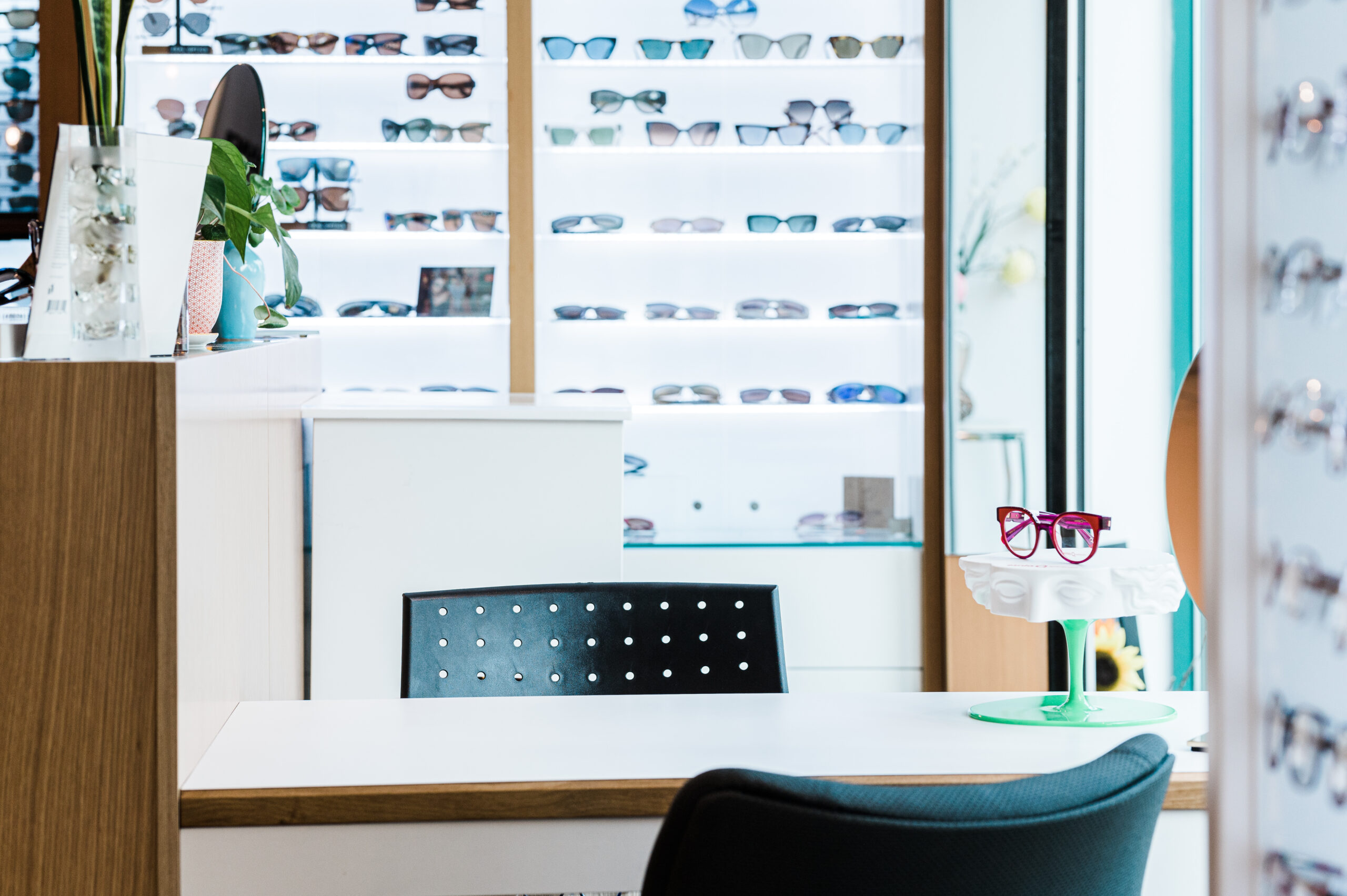
Eye Exams with Nicola Eye Care in Kamloops
We work with families from across Kamloops and the surrounding area to ensure good lifelong vision and eye health. A comprehensive eye exam is the backbone of our preventative eye care routine.
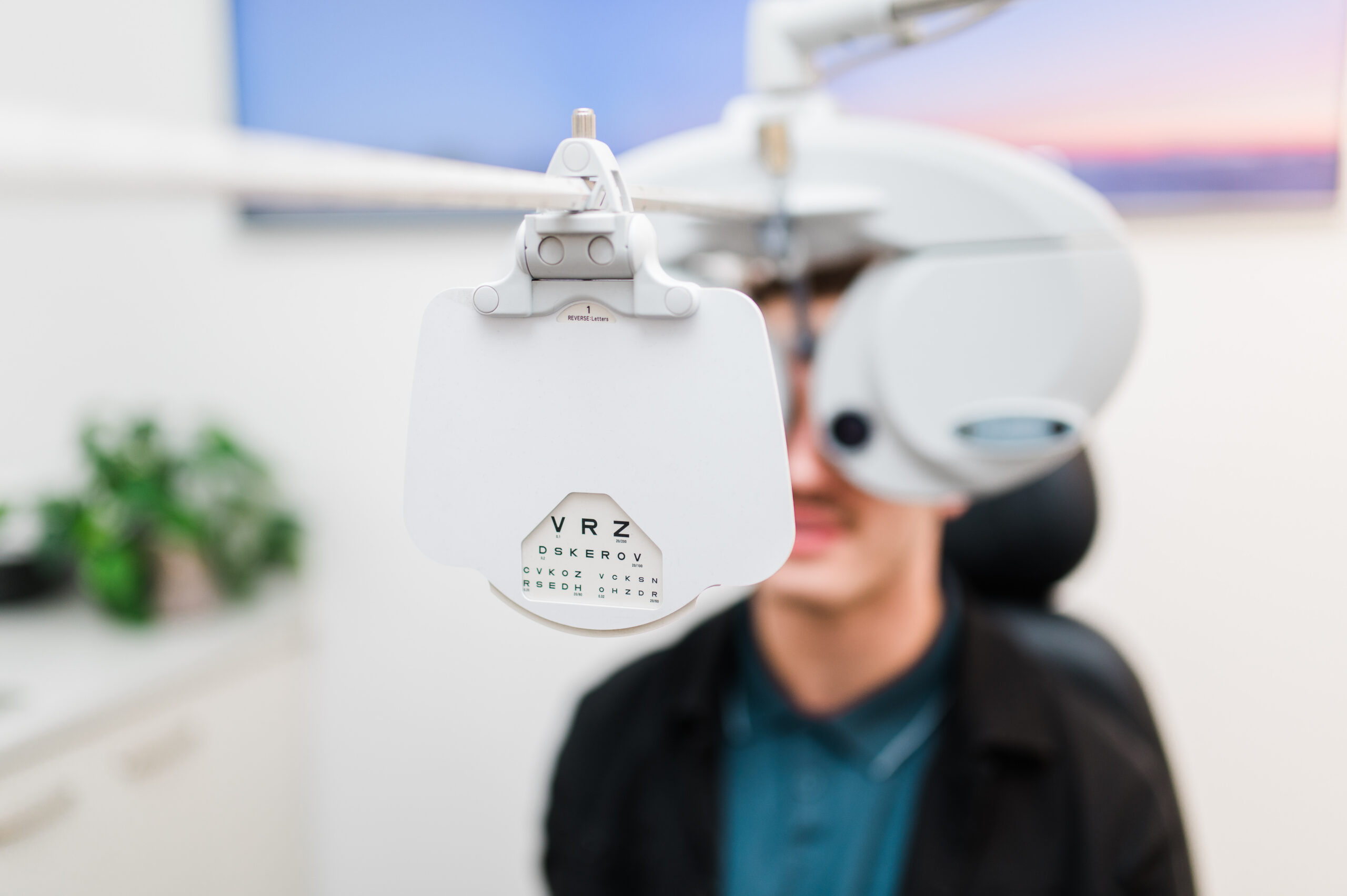
Your comfort is our priority.
Adult Eye Exams
At Nicola Eye Care, we recommend having a comprehensive exam annually to help ensure we always stay on top of your eye health.
We work hard to provide Kamloops with an enjoyable eye care experience. Powered by high-tech equipment, our eye exams are completely non-invasive and designed with your comfort in mind.

What You Can Expect From Nicola Eye Care
Honest, straightforward advice: No 2 eyes are the same. Informed by our exam results, our eye doctors will let you know of any concerns they have or what the appropriate next steps may be. Throughout our relationship, one thing that will remain true is our focus on your health and visual acuity.
A comprehensive, in-depth exam that screens for known diseases and conditions: Our eye care is focused on preventative detection and treatment of vision-threatening conditions. Our eye exams definitively screen for signs of all known eye diseases.
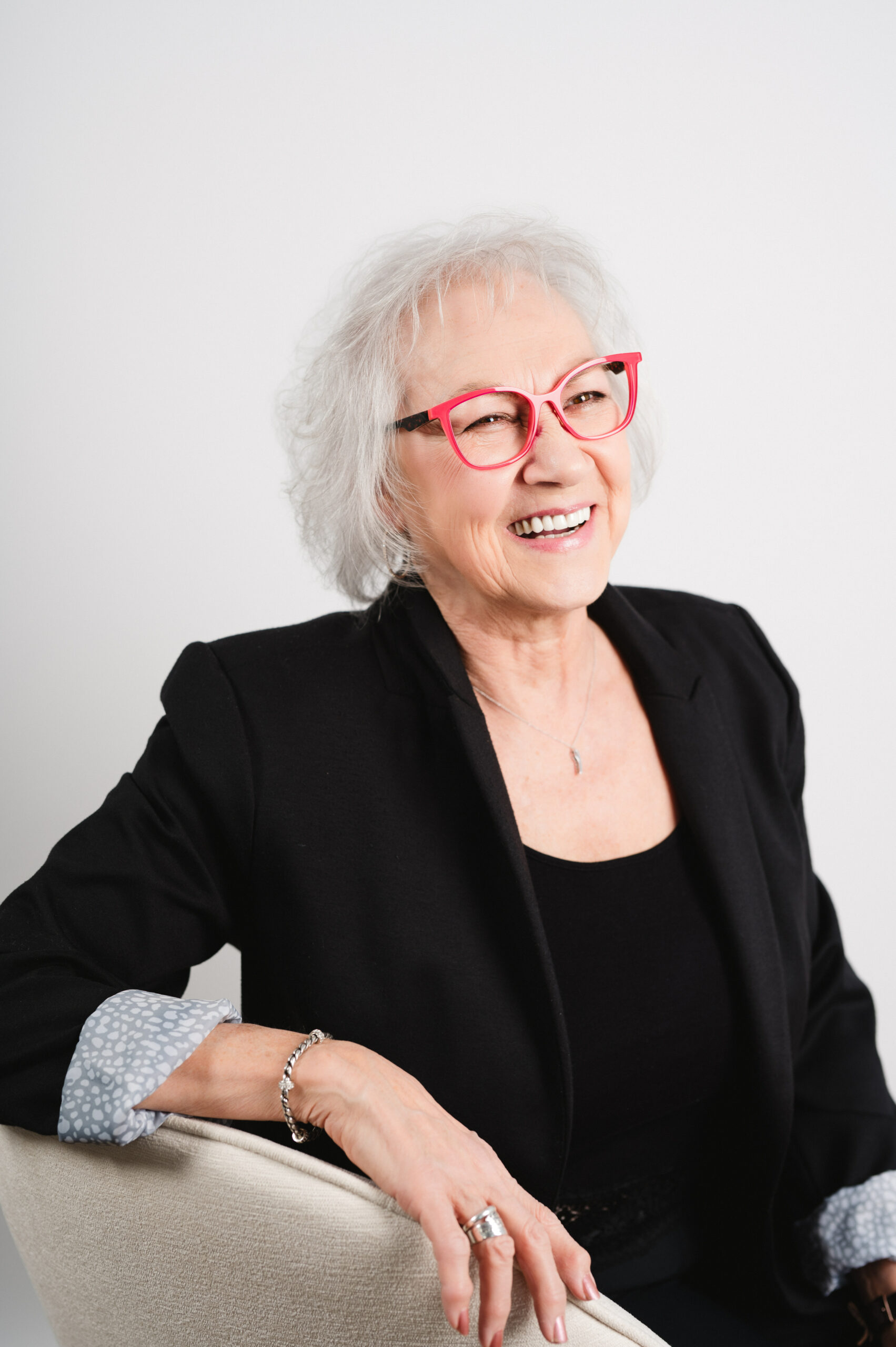
Excellent Options for Improving Your Vision
Nearly 75% of North American adults wear glasses or contact lenses. All over the western world, rates of myopia (the most common refractive error) are increasing.
Our optometrists are experts in vision correction, specializing in both cutting-edge optics (using our in-house optical lab and eyeglass lens edger) and contact lens fittings.
Find Your Style in Our Optical Boutique
We carry over 1200 optical frames in-stock and are ready for our patients to try on. No matter your face shape, skin tone, or sense of style, we promise to make the selection process fun and exciting.

FAQs
Eye exam fees
Our fees for adult eye exams start at $140 and can go up or down depending what the doctor finds. If any supplementary testing is needed due to an eye concern or emergency, this fee may increase. BC Medical may cover a portion of the eye exam as well if the doctor finds you are eligible for this coverage, based on your eye health. Be prepared to pay as little as $92, and as high as $160. If you have any coverage through the ministry (social services, disability, PWD etc.) They will only cover around $44.83. The patient will be responsible for the remaining amount of the eye exam fee.
We submit to most extended benefit companies as well, with some exceptions. If you have not signed up for e-claims, or your benefit plan requires a manual submission, you may need to pay for the eye exam and submit a manual claim. Unfortunately, we are unable to know ahead of time if this is the case, and we are not able to look up coverages – it is confidential information that only you can access – so find out ahead of your appointment so there are no surprises!
Extended Benefit Companies
Green Shield
SSQ Insurance
MEDIC Construction (Green Shield Canada)
Empire Life
Pacific Blue Cross / Medavie Blue Cross
Sunlife
Alberta Blue Cross (Telus Health Portal)
Beneva Inc.
BPA – Benefit Plan Administrators
Canada Life (Formerly Great-West Life)
Canada Life – PSHCP
Canadian Construction Workers Union
Chambers of Commerce Group Insurance
CINUP
ClaimSecure
Coughlin & Associates LTD.
Cowan
D.A. Townley
Desjardins Insurance
Equitable Life of Canada
First Canadian
GMS Carrier 49
GMS Carrier 50
GroupHEALTH
GroupSource
Industrial Alliance
Johnson Inc.
Johnson Group Inc.
LUNA Local 183
LUNA Local 506
Manion
Manulife Financial
Maximum Benefit
People Corporation
RWAM Insurance Administrators
Simply Benefits
TELUS AdjudiCare
Union Benefits
UV Insurance
TRU Benefits – Greenshield (Must use TRU student ID to submit)
We CANNOT Submit to other Provincial Plans not specified above.
We CANNOT Submit to “TECK Sunlife” or Sunlife policies beginning in “055555”
What happens during my eye exam?
After checking in at the front desk, we may borrow your glasses to read the prescription from your current eyeglasses. We will do this specifically if you are a new patient, and/or your glasses were made elsewhere. It allows the doctor to assess if your current glasses are working well or if its time for an update after your eye exam. If you are wearing contact lenses on arrival to your exam, we may have you remove them before pretesting.
Next, you will head off with our friendly technicians to complete some preliminary pretesting machines, measuring and collecting information for the doctors to evaluate with you during your eye exam. This includes an auto-refraction, pressure test, retinal images, and in some cases some additional glaucoma testing, such as a Visual Field test or Ocular Coherence Tomography. Many factors including age are taken into account when evaluating what information, we need to collect – it may be different for everyone!
During your eye exam, you will complete a full health examination. This includes eye movement, tracking, and color vision, slit lamp exam which includes viewing the eyelids, conjunctiva, iris, intraocular lens, sclera, cornea, retina and optic nerve. High-definition digital retinal photos will be taken, with our Optomap machine, Glaucoma testing (peripheral vision testing) and eye pressure test will be completed during your visit. Corneal thickness measurements will be taken, and a check for any underlying eye conditions such as dry eye or gland dysfunctions. Our eye exams also detect issues such as high cholesterol, hypertension, cancer, auto-immune conditions and more! The eyes are truly a window to your complete overall health.
Next, the vision component of our eye exams. This consists of a refraction to determine refractive errors such as myopia, hyperopia, astigmatism, presbyopia and more. A glasses prescription will be provided at the end of your appointment with PD measurements included.
What about contact lenses?
If you wear contact lenses, or are interested in wearing them, the doctor will discuss with you during the exam, and perform a few additional checks for eligibility. They will assess health and curvature of your cornea and possibly the size of your pupil. All these measurements will help the doctor prescribe the right size lenses, and choose the best material and type of lens for your unique eyes. In certain instances, you might also have to undergo a tear evaluation. During this test, the doctor is looking for signs of dry
eyes, which could limit the amount of time you should be wearing contact lenses, or affect your eligibility as a whole. Contact lens exams may require additional tests and may include a fitting fee.
A contact lens is a medical device and can be worn to correct vision, as well as for cosmetic or therapeutic reasons. In Canada, all contact lenses, even purely cosmetic ones, require a prescription. They must be properly fitted and prescribed by an Eye Care Professional. Prescriptions for contact lenses and glasses may be similar, but are not interchangeable. Contact lens prescriptions generally expire on a yearly basis, unless otherwise determined by your eye doctor.
For new contact lens wearers, you will usually be booked back in for a contact lens fitting and training after your eye exam, where our knowledgeable technicians will teach you how to insert, remove, clean and care for your contact lenses. We will educate on wearing time, wearing schedule, and do’s and don’ts of contact lens wear. The doctor will then evaluate the lenses on your eyes (if successful with training) and determine if the trial lenses will be a good fit, and vision is clear with the lenses. If you or the doctor have any initial concerns or questions, it can be discussed at this time. You will then take some trial (free) lenses home to try and wear for the next 1-2 weeks (according to your wearing schedule). You will come back in 1-2 weeks’ time for a final contact lens check, and will have the contact lens prescription finalized. You will then be able to take a copy of this contact lens prescription with you, and you are free to place an order for retail lenses with us! There is always a fee for the initial fitting + training, but the final contact lens check is free of charge.
How do I know which contact lenses will work best for me?
When determining what type of contact lenses to try, there are several factors. Often the doctor will choose a lens they feel would work best with your eyes and prescription, but there is a bit of choice that you as the patient get to decide!
Soft Contact Lenses:
There are many soft lenses that come as a daily disposable, monthly disposable and 2-week disposable. These are the most common, inexpensive, and easy to fit contact lenses, and most patients will tolerate them well. Comfort is exceptional with soft lenses, and they can sometimes provide other benefits such as U.V. protection, blue light blocking and anti-fatigue properties. Newer soft lens materials include silicone-hydrogels to provide more oxygen to your eye while you wear your lenses.
- Daily disposable: Convenience over cost – there is very little care required for daily lenses, you wear them once (usually up to 12-14 hours per day) and dispose of them. For this reason, they tend to be more expensive that 2 week or monthly lenses – but work great for those wanting lenses for special occasions, sports, or very occasional wear.
- Monthly disposable: Cost over convenience – Monthly lenses do require daily cleaning and storage in fresh solution when not wearing the lenses. They are good for 30 days from the moment you open the foil packaging. They are relatively inexpensive when purchased in 6 month or 1-year supplies. These are great for someone wanting to wear contact lenses more often than glasses.
- 2-week disposable: Mix of convenience and cost – less expensive than dailies, but still require cleaning and care daily. They are good for 14 days once foil packaging has been opened. Good for someone wanting to wear for semi-full time, holidays, or for occasional wear.
- Toric lenses for astigmatism: Available in a daily, monthly, or 2-week: Toric contact lenses are for those with an astigmatism correction—with or without the presence of additional refractive errors. The special shape of a toric lens creates different refractive, or focusing, powers that can help correct either a corneal or a lenticular astigmatism. Toric contacts have a thicker zone that keeps them from rotating when they’re in your eyes. It also helps you orient the lenses the same way every time, so you can count on consistent visual acuity. These can be slightly more expensive than a spherical contact lens (lens without astigmatism correction). Your doctor will determine if you need toric contact lenses – sometimes the astigmatism is so insignificant you may be prescribed a spherical contact lens even if you do have mild astigmatism.
- Multifocal contacts: Available in a daily or monthly lens – patients that are Presbyopic (usually over the age of 40+) and require a prescription for distance, and for near (reading) can have contact lenses that accommodate multiple prescriptions on a single lens to help you see clearly at a range of distances. These optics will not be as clear as with glasses, but will allow patients to functionally navigate with contact lenses instead of glasses even if have Presbyopia.
- Monovision: Available in a daily or monthly lens – Monovision contact lenses are one of several common ways that people correct for presbyopia as they age. In order to address the difficulty in changing focus between near and far, one contact lens is prescribed for near vision and the other eye contact lens for distance. This can take some time for the brain to adjust to, but will be less expensive than Multifocal contact lenses.
- Multifocal contacts for Astigmatism – Available only in a monthly lens – If you are presbyopic and have astigmatism, you are still able to wear contact lenses! These are only available in a monthly lens design, and can be expensive due to their specialty design.
- Colored contact lenses – Available only in a monthly lens – Air Optix Colors offer a spherical monthly lens if you are looking for colored contact lenses. Unfortunately, they do not come in a toric lens for astigmatism, and do not come in a multifocal option either. If interested in colored lenses, we would book you in for a training, where staff will have you try on different color options, and from there you can choose which color(s) you like best to have the doctor approve with a fitting.
Gas Permeable (GP) contact lenses:
Also known as rigid gas permeable (RGP) lenses, are hard contact lenses made of silicone-containing compounds that allow oxygen to pass through the lens material to the eye. Though not as popular as soft contact lenses, GP lenses offer a number of advantages over soft lenses. GP lenses require an adaptation period before they are as comfortable as soft contacts. GP contacts are also excellent for patients with keratoconus, where the cornea is cone-shaped and causes extreme visual distortion. Some people with high astigmatism for whom soft contacts don’t produce the desired visual acuity will also benefit from this type of lens. These lenses range usually from a few hundred dollars, and the fitting is more expensive than with soft lenses.
Orthokeratology, or Ortho-K:
Specially designed and fitted contact lenses to temporarily reshape the cornea to improve vision. It’s like orthodontics for your eyes and the treatment is often compared to dental braces. This lens changes the curvature of the cornea to temporarily improve the eye’s ability to focus on objects. This procedure is primarily used for the correction of myopia (nearsightedness). Overnight Ortho-K lenses are the most common type of Ortho-K. This type of lens is more expensive, and the fitting appointment can be more expensive and in-depth as well.
Scleral lenses:
Scleral contact lenses offer sharp vision and comfort for dry eyes, irregular corneas or hard-to-fit eyes. They are very helpful for patients with keratoconus. Scleral contacts are large- diameter gas permeable contact lenses specially designed to vault over the entire corneal surface and rest on the “white” of the eye (sclera). In doing so, scleral lenses functionally replace the irregular cornea
with a perfectly smooth optical surface to correct vision problems caused by keratoconus and other corneal irregularities. Also, the space between the cornea and the back surface of a scleral lens acts as a fluid reservoir (filled with saline) to provide comfort for people with severe dry eyes who otherwise could not tolerate contact lens wear. These can be expensive lenses, and the fitting fees are higher as well.
Most patients will benefit from disposable soft contact lenses, but its best to discuss this during your eye exam to determine what’s best for you!
Can’t I just order contact lenses online without a prescription?
Purchasing contact lenses online may seem convenient, but it comes with risks to your vision and eye health. Contact lenses are Health Canada approved and FDA regulated medical devices. Each contact lens product is uniquely designed for a particular purpose, such as for providing clear vision, cosmetic appearance, or treatment of certain eye diseases. Improper use of contact lenses can put people at risk of eye infections, allergic reactions, dry eyes, and, in some cases, vision loss.
Beware, some online contact lens websites in Canada are not authorized sellers of contact lenses. This should concern you as a buyer of contacts online! As the Canadian Association of Optometrists warns “Overseas distribution channels may have grey market (counterfeit) product. There are no controls to ensure that Internet sites source lenses directly from the manufacturer.”
This means that some websites may be buying their contact lenses from places like China, Vietnam, India, The Philippines or other nations where false or counterfeit contacts can be produced and distributed here in Canada. Moreover, the quality controls in other nations are sorely lacking. In other words, some Canada-based websites deal in “grey market” lenses to make more profit.
This is why it’s important to have a proper contact lens fitting appointment with your Optometrist. During a contact lens selection process, various factors are considered including the prescription, material, curvature, diameter, fit, coating, oxygen permeability, deposit resistance, moisture content, cleaning solution, and lifespan of the lens.
Once you have completed the fitting process, and have the contact lens prescription finalized, you will be able to order contact lenses with your specific parameters. Glasses and contact lens prescriptions will be different from one another. They contain different information on them and may even have a different prescription! Contact lenses are adapted to sit on the surface of the eye, rather than a few millimeters away from the eye, which is why the two prescriptions are not interchangeable.
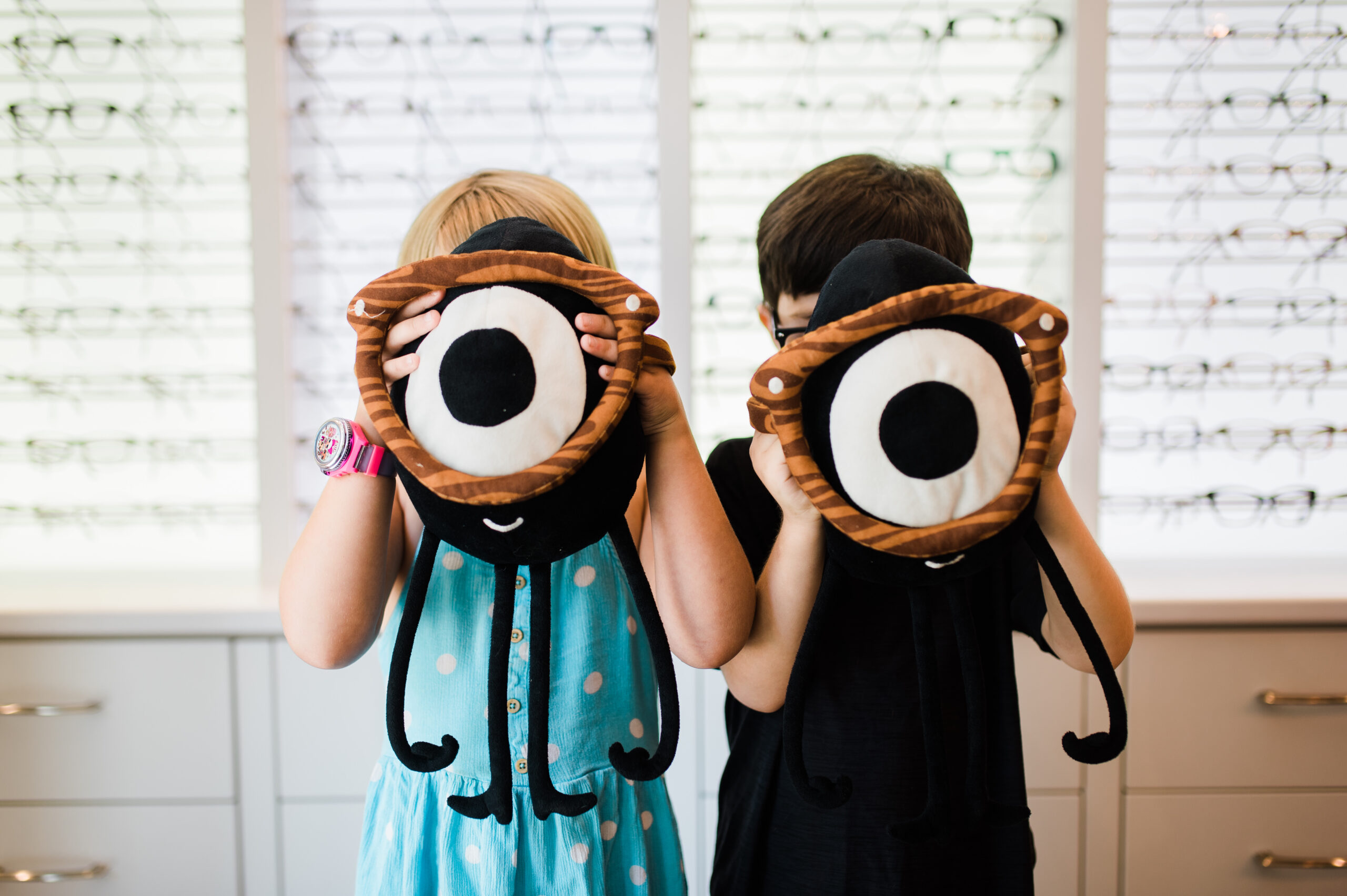
Childrens Eye Exams
The Nicola Eye Care practice has been serving local families for generations, and we continue to provide the finest, most advanced pediatric eye care in the area. Children’s eyes are not the same as adults, and they require special attention. One exam every 12 months is all it takes.
Since 80% of what children learn in school is visual, regular eye exams can also help prevent vision problems from impacting their academic development. According to The Canadian Association of Optometrists, children should have their first annual eye exam between 6 and 9 months old. However, if you are concerned about your children’s vision, it’s best to bring them in sooner.
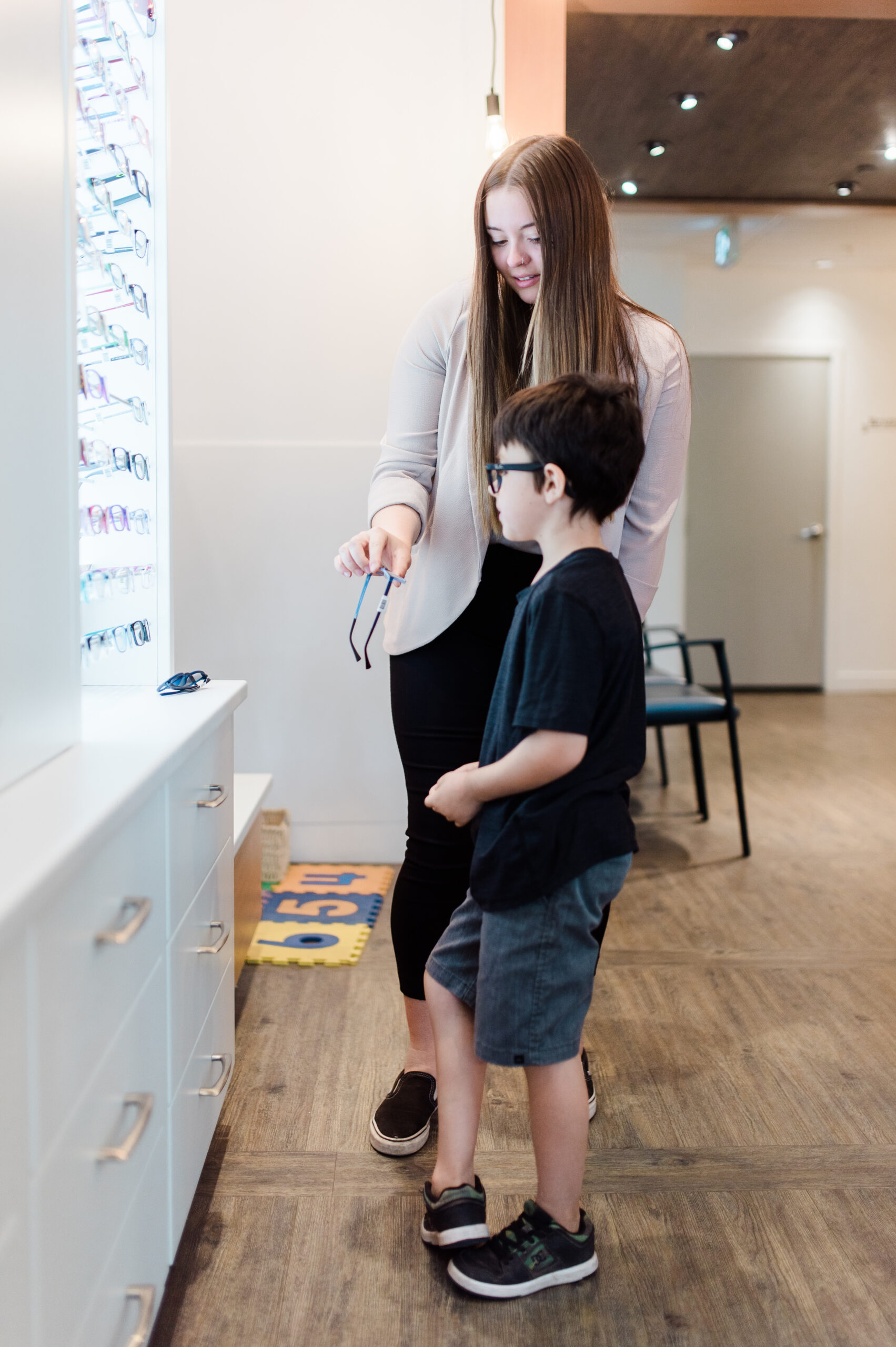
HOW WE SUPPORT YOUR CHILD’S EYE CARE
When you take your child to our practice for an eye exam, we look for potential vision problems and ocular health risks by asking questions and running tests. At the end of the exam, we’ll recommend the next steps for treating or managing any issues we’ve uncovered.
Eye health exams can be scary for children, much like dental appointments. Since good eye health is critical to any child’s development and learning, we’ve designed a beautiful office space where children feel relaxed and at home. Children are often unaware of any problems with their visual acuity (eyesight), and so we implement a range of tests which examine:
- The whole visual field (is there any trouble with peripheral vision?)
- Focusing ability
- Eye teaming
- Ability to track
- Corneal shape (astigmatism)
- If a prescription is required
- Eye health is as it should be (are my child’s eyes developing properly?)
- If screen time is affecting growth and development
FAQs
How much does it cost for a children’s eye exam?
Kids are covered by B.C. medical for their eye examinations annually. At age 10 we begin doing ultra- wide retinal imaging which comes with a fee of around $34. It can be slightly more if they are over 10 years old and wear contact lenses as well.
How old does my child need to be to have an eye exam?
We can start seeing children as early as 6 months old, to ensure the eyes are healthy and developing as they should be. Once they start school, they should be seen every year, or sooner if any eye issues are detected.
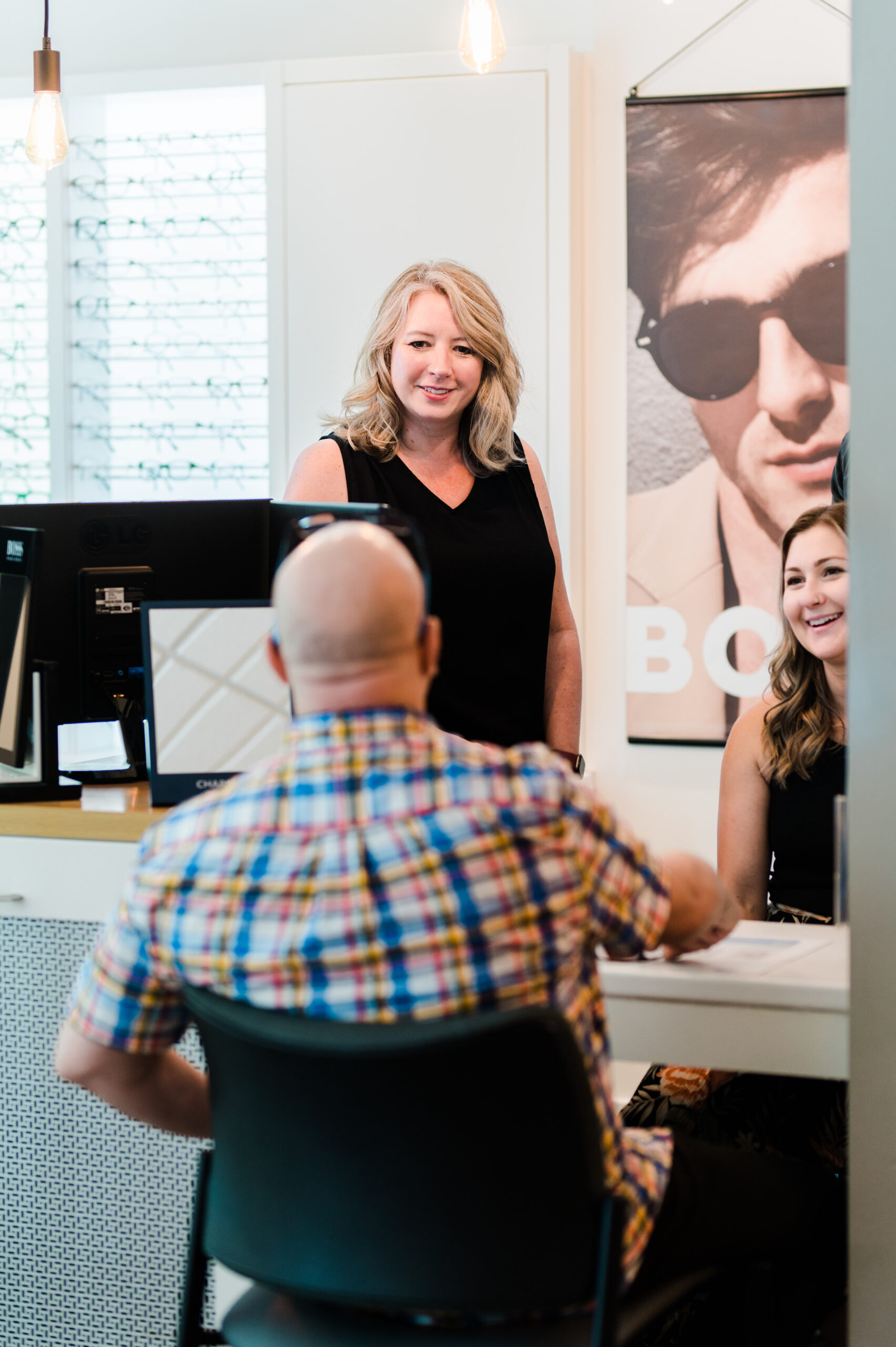
Seniors Eye Exams
We’ve been providing exceptional eye care to our patients for over 60 years, and we’ve learnt to be extra-vigilant about eye health in older generations. Since our bodies naturally get weary over the years, we become more susceptible to visual problems as we age.
Even if your eyesight appears totally fine, some diseases can manifest with no observable symptoms and a once-a-year eye exam – which only takes 60 minutes – is the best and only way to detect them before they cause lasting changes to your vision.

What to Expect from Seniors Eye Exams
We are an experienced practice, and we never miss a chance to upgrade our equipment in order to detect sight threatening eye diseases before vision loss occurs. Everything we use at Nicola Eye Care is useful, effective, and of the highest technology available:
- Optomap California
- Humphrey Field Analyzer 3
- Zeiss Cirrus HD Optical Coherence Tomography (OCT) – Model 500
- Nidek 530P OPD Scan III Wavefront Aberrometer, Corneal Analyzer, and Refractive Power Analyzer
- Nidek Non-Contact Tonometer and Pachymeter
- Oculus Keratograph 5M Corneal Topographer, Keratometer, and Meibography
This technology allows us to make faster, more accurate diagnoses than ever before, while maintaining the non-invasive and safe nature of our exams. Your eye health is our absolute priority.
More Information about our technology
Optomap California
With California, Optos has incorporated new technology enabling practitioners to see more, discover more, and effectively treat more ocular pathology thus promoting patient health. In addition to a field of view of 200 degrees or 82% of retina in a single image capture, California, offers the following benefits:
- Visibility of 50% more of the retina when compared to other conventional imaging devices – Motorized head and chin rest to more easily align those patients who require additional assistance during imaging
- Multiple imaging modalities including color rg which produces three images in a single capture (color rg, sensory red-free, and choroidal in a single image) and introducing color rgb which produces four images in a single capture (color rg, color rgb, sensory red-free, and choroidal) and autofluorescence.
- Dye-based imaging modalities fa and icg as well as interweaved angiography for parallel capture of fa and icg images without manually switching between imaging modalities
Oculus Keratograph 5M
The OCULUS Keratograph® 5M is an advanced corneal topographer with a built-in real keratometer and a color camera optimized for external imaging. Unique features include examining the meibomian glands, non-invasive tear film break-up time and the tear meniscus height measurement and evaluating the lipid layer.
The tear film is assessed using either white or infrared illumination. The new high-resolution color camera makes even the finest of structures visible. In addition to NIKBUT (Non-Invasive Keratograph® Break-Up Time) and measurement of the meniscus tear, the TF-Scan can also make an assessment of the lipid layer and the tear film dynamics. Tear film analysis with the OCULUS Keratograph® 5M is non-invasive and is conducted without any additional tools.
The multi-functionality of the Keratograph® 5M easily and efficiently integrates difficult examinations such as meibography. The dysfunction of meibomian glands is the most frequent cause of dry eye. Morphological changes in the gland tissue are made visible using the Meibo-Scan and can be classified with the JENVIS Meibo Grading Scales.
Humphrey Field Analyzer 3
Humphrey field analyser (HFA) is a tool for measuring the human visual field. (Central and peripheral vision).
The results of the analyser identify the type of vision defect. Therefore, it provides information regarding the location of any disease processes or lesion(s) throughout the visual pathway. This guides and contributes to the diagnosis of the condition affecting the patient’s vision. These results are stored and used for monitoring the progression of vision loss and the patient’s condition.
Common conditions found with visual field testing include glaucoma, cone-rod dystrophy, retinitis pigmentosa, macular degeneration, optic neuritis, congenital optic neuropathies, brain tumors, lesions in the brain due to strokes, pituitary disorders, multiple sclerosis, brain trauma, and more.
Zeiss Cirrus HD Optical Coherence Tomography
In 1996, ZEISS introduced the first OCT system in eye care and since then OCT has become the standard of care in eye clinics. Optical coherence tomography (OCT) is an optical imaging technique that provides high resolution, cross-sectional measurements of the retinal nerve fiber layer (RNFL) and macula.
Optical coherence tomography (OCT) is a non-invasive imaging method that uses reflected light to create pictures of the back of your eye. It can be used to diagnose and manage diseases like diabetes-related retinopathy, glaucoma, macular edema, and more. Imagine it like a cake – we can see the top of the cake and the icing using the 2D digital retinal photography (fundus camera), but the 3D image produced from an OCT scan slices the cake in half and turns it on its side so we can see all the layers inside.
OCT can help diagnose the following: Glaucoma, Diabetic retinopathy, Detached retina, Age-related macular degeneration, Macular hole and more.
Nidek 530P OPD Scan III Wavefront Aberrometer
The OPD-Scan III is an autorefractor, keratometer, pupillometer (up to 9.5mm), corneal topographer, and integrated wavefront aberrometer. The OPD-Scan III completes 20 diagnostic metrics in less than 10 seconds per eye! OPD-Scan III is a device that mainly measures corneal shape (topographer) and refractive error (refractometer). It clarifies causes of vision difficulties through wavefront analysis of information measured over a wide area. This gives the doctor a rough idea of what your prescription might be, and the doctor then uses this information to perform a subjective refraction to finalize.
Nidek Non-Contact Tonometer and Pachymeter
Non-contact tonometers are widely used to measure the internal eye pressure, i.e. the IntraOcular Pressure (IOP), which is an important parameter for the diagnosis and treatment of glaucoma. During the measurement, the eye is deformed by a short air pulse.
The pachymeter performs a test that measures the thickness of the cornea, the clear membrane located at the front of the eye. The cornea generally measures around 500 or 600 microns in the central area. Concerning refractive surgery, a pachymetry is one of the most important examinations for determining whether a person should undergo laser treatment for their myopia, hypermetropia or astigmatism, since the surgery modifies the shape of the cornea, extracting a certain amount of tissue which will directly affect the thickness of the cornea. Therefore, the cornea should be thick enough to correct a given number of dioptres. It is also a diagnostic tool for some pathologies that cause a thinning of the cornea as per the case with Keratoconus or even those that cause thickness as per the case with corneal edema.

Diabetic Eye Exams
If you are diabetic, it is critical that you take active control over your eye care – diabetes can cause a vision-threatening illness called diabetic retinopathy (which only affects those living with diabetes).
We offer a eye exams designed to: Examine the retina for any signs of diabetic retinopathy, assess visual acuity (i.e. how well you see), quantify the stage and severity of diabetic retinopathy, if applicable, and recommend any treatment or lifestyle advice necessary to manage the condition.

Has it been more than 1 year since your last screening?
Arrange an eye health exam with our practice right away – you may not notice any symptoms of diabetic eye disease before your vision is quite compromised. Diabetic retinopathy can virtually destroy your vision if left untreated.
Screening allows us to diagnose early, which means we can initiate effective treatment and management plans before your vision becomes irrevocably hampered.
Since around 40% of people with diabetes are likely to experience a degree of retinopathy, an eye health exam which reveals no ocular health issues can take a load off your mind, helping you manage the disease with one less thing to worry about.